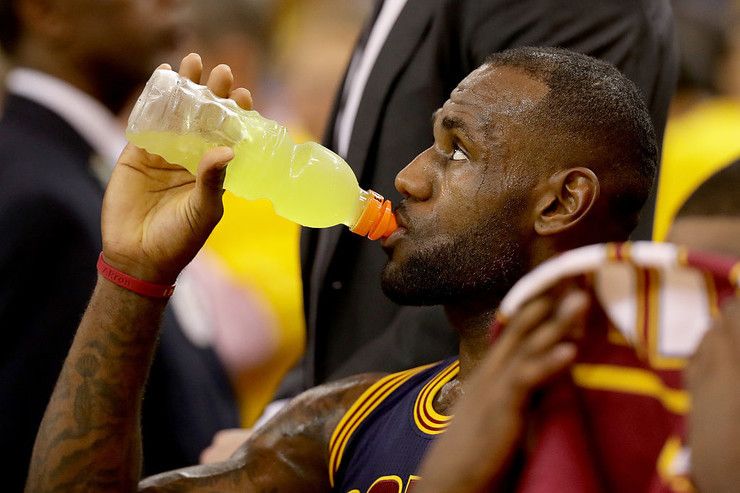
By Marcus Bryant and Robert L. Herron |
During exercise an athlete sweats; this results in the loss of body water and electrolytes. The evaporation of sweat helps to regulate the body’s core temperature. However, even though sweating is an important homeostatic mechanism, excessive water and electrolyte loss can negatively impact performance and safety.
Generally speaking, a basketball player can have impaired performance when they have lost ≈ 2% of their body weight via fluid loss. The deleterious effects of dehydration include slower sprints time, reduced lateral movements, and a lower shooting percentage and take place in youth and adult athletes. Furthermore, prolonged and extreme dehydration can result in health and safety risks.
Unfortunately, measuring hydration is not as easy as one would hope. In the field, monitoring body weight changes (day-to-day change of > 1% is relevant for fluid intake), subjective thirst, and urine color (preferably morning urine color) are helpful. If you can monitor all three, then any combination of the three can give you some indication – and the more evidence you have, the more confident you can be. Additionally, practitioners can calculate individual sweat rates during regular training activities by monitoring body weight changes and correcting for food or drink intake. Gatorade Sports Science Institute calculator linked here.
However, not all is lost. Dehydration, hypohydration, and fluid balance can be managed. One of the best ways to manage one’s hydration status is to practice and maintain quality, off-court-hydration habits. Arriving at practice, training sessions, and games in a euhydrated state (i.e., hydrated) is a great start. Additionally, the pace of the game and training sessions (indoors) should allow athletes to replace the majority of the fluids they are losing during activity if the fluid is cool, tasty, and – most importantly – available. It should be noted that playing in high ambient temperatures (outdoors or indoors) will increase heat stress and strain. Therefore, playing in hot and humid conditions will require more fluid intake to maintain fluid and electrolyte balance.
Basketball athletes are encouraged to try to match or closely match fluid lost during activity to keep fluid loss to a minimum (≤ 2% of body weight lost). This recommendation is true in all sports, but each sport has sport-specific challenges that need to be considered.
It is common for people to suggest an athlete replace 150% of what is lost because ≈ 30% of fluid ingested is lost via urine when fluid is consumed quickly. For example, if an athlete has lost 1 kg of body weight (2.2 lbs.) then, ≈ 1.5 liters of fluid (50 oz) would be needed to match the 150% replacement target. The more time and meals athletes have between sessions, the easier it will be for them to replace and meet their needs. Context and individualized plans need to be considered. Of note, there is also a health risk to over hydrating – called hyponatremia. Essentially, if people create a mismatch with too much fluid and too-little sodium, the electrolyte imbalance can be deadly. Therefore, an individualized approached – based on needs – is important.
To prioritize hydration, athletes, coaches, family, and support staff need to do the following:
- Attempt to quantify the athlete’s sweat rate and fluid needs for their activity – this case – basketball.
- Have a monitoring system in place that includes at least one or a combination of: body weight, thirst, and urine color tracking.
- Create a plan to help the athlete meet their needs and adjust as needed.
Taking into consideration the importance of hydration on basketball players’ athletic performance, it is the responsibility of the player, coach, staff, and family to take an active role in improving and maximizing safety. Hydration is one piece of the puzzle in creating a safe environment aimed at improved performance.
Marcus Bryant is from Philadelphia, PA and has been a collegiate men’s basketball coach for 18 years. He has also held the position of adjunct kinesiology professor for the past three. He now resides in Long Beach, CA.
Robert L. Herron is Acting Director of Sport Exercise Science at the United States Sports Academy. Robert is a Certified Strength and Conditioning Specialist® with distinction from the National Strength and Conditioning Association (NSCA-CSCS*D®) and a Clinical Exercise Physiologist through the American College of Sports Medicine (ACSM-CEP®). rherron@ussa.edu
Fascinating stuff. Nice work!